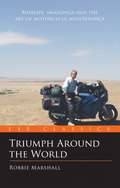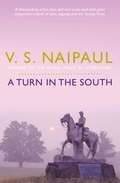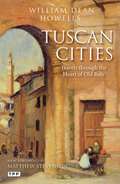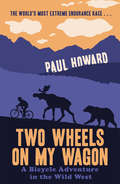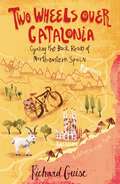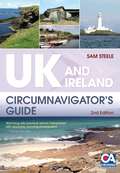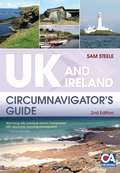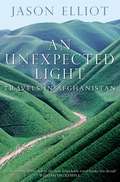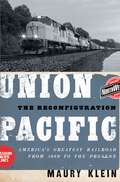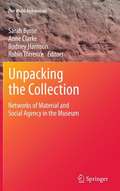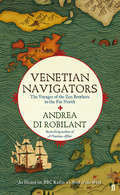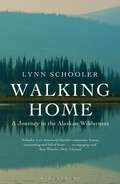- Table View
- List View
Triumph Around the World: An Eye Classic (Eye Classics)
by Robbie MarshallRobbie Marshall had it all - love, children and a successful business. So why did he trade it all in for the saddle of a Triumph Trophy and an out-of-date world atlas? Robbie knew that if he did not indulge his desire to explore, he would regret it for the rest of his life. After shipping his Triumph motorbike to the United States, Robbie kick-started his life on a journey that would take him across five continents and around the globe. Despite witnessing a gangland execution, sleeping rough, getting imprisoned and mugged, Robbie had the time of his life. Triumph Around the World is one hell of a ride.
A Turn in the South
by Sir V. S. NaipaulA Turn in the South is a reflective journey by V. S. Naipaul in the late 1980s through the American South. Naipaul writes of his encounters with politicians, rednecks, farmers, writers and ordinary men and women, both black and white, with the insight and originality we expect from one of our best travel writers. Fascinating and poetic, this is a remarkable book on race, culture and country. ‘Naipaul’s writing is supple and fluid, meticulously crafted, adventurous and quick to surprise. And, as usual, there’s the freshness and originality of his way of looking at things’ Sunday Times ‘Naipaul writes as if a modern oracle has chosen to speak through him. It is a tissue of brilliantly recorded hearsay, of intense listening by a man with a remarkable ear’ New York Times Review of Books ‘This is a journey below the Mason–Dixon line into a society riven by too many defeats; the broken cause of the old Confederacy, and the frustrated anger of Southern blacks whose power is circumscribed . . . It is the best thing outside fiction that I have read on the Old South pregnant with the new since W. J. Cash’s The Mind of the South published over fifty years ago’ Sunday Telegraph
Tuscan Cities: Travels Through the Heart of Old Italy (Barnes and Noble Digital Library)
by William Dean Howells"It was their lovely ways, far more than their monuments, that made the Florentines delightful. I would rather have had a perpetuity of the cameriere's smile than Donatello's San Giorgio."Tuscany is arguably the most alluring and iconic region of Italy. It is a place of breathtaking natural beauty, imbued with an ancient and rich cultural heritage that, as Shelley's 'paradise of exiles', has inspired centuries of artists, scientists writers, poets and travellers. For William Dean Howells, American Consul to Venice for four years, Italy was the country that fashioned his prose and fostered his love of travel. One winter he travelled the length and breadth of Tuscany, from Florence and Fiesole to Siena, Pisa, Lucca, Pistoia and Prato. Immersing himself in all things Tuscan, he describes in compelling detail the daily life - funerals and weddings, military marches and lovers' trysts - of a place that was bursting with life and endlessly fascinating to him. He muses on the character of the Italians that he meets, revelling in their sense of drama, their sentimentality and impulsiveness and vividly resurrects the artistic, tempestuous, world-changing history of Tuscany, from its mysterious, ancient beginnings to the birth of the Renaissance and its status as cultural soul of Italy. Tuscan Cities, a passionate Italophile's glowing tribute, cannot fail to inspire anyone who has ever travelled to or loved Tuscany as Howells did.
Two Masted Ship (tactile)
by Adrian FarnsworthThis is an image of a large old sailing ship. It is a side view with the stern on the right of the page and the bow on the left of the page. The masts have a number of rectangular sails and each mast has a long flag flying out to the right.
Two Wheels on my Wagon: A Bicycle Adventure in the Wild West
by Paul HowardAs bicycle races go, the attractions of the Tour Divide are not immediately apparent. For a start, it is the longest mountain-bike race in the world, running nearly 3,000 miles down the Rockies from Canada to Mexico. But the distance is not the only challenge - the total ascent of 200,000 ft is the equivalent of scaling Mount Everest nearly seven times.Then there are the dangerous animals likely to be encountered on the route: grizzly bears, mountain lions and wolves, not to mention rattlesnakes and tarantulas. Worse, the rewards for all this effort are strictly limited. Unlike in the Tour de France, there is no fabled yellow jersey and no prize money.Yet, undaunted, and in spite of never having owned a mountain bike, Paul Howard signed up. Battling the worst weather for generations, drinking whiskey with a cowboy and singing karaoke with the locals, Howard's journey turned into more than just a race - it became the adventure of a lifetime.
Two Wheels Over Catalonia: Cycling the Back Roads of North-Eastern Spain
by Richard GuiseSixteen years after moving to Catalonia, Richard finally finds time to slow down and explore the back roads by bicycle. Dipping into the unique history of this fiercely independent nation-within-a-nation, and chancing upon nudist beaches, ancient Iberian sites and revolutionary road-sweepers, this slow cyclist revels in authentic Catalonia.
UK and Ireland Circumnavigator's Guide
by Sam Steele"The new circumnavigation bible" - Geoff Holt (the first disabled sailor to sail around Britain singlehandedly)A circumnavigation of the UK and Ireland is the perfect 'doorstep'challenge for sailors and motorboaters looking for an extended cruisewhich doesn't take them too far from family and responsibilities andallows them to keep in touch. It doesn't require extended time offwork, or linguistic ability if things go wrong - and the coastline isbeautiful! This book is a practical guide and Sam gives advice on planning andpreparation: when to leave, whether to go clockwise or anti, whatcharts are needed, how much it is likely to cost, possible routes (viacanals or 'the long way'), what stores and equipment are needed, likelypitfalls en route, and what types of running maintenance might berequired. For the second edition she has added a '10 of the best'section detailing 'unmissable' places in a range of categories fromremote bays and beautiful rivers to historic locations and anchorages.UK and Ireland Circumnavigator's Guide isperfect for all those sailors and motorboaters planning as well asdreaming of one day circumnavigating Britain's beautiful islands. 'A comprehensive guide to sailing (or motor boating) round Britain' Sailing Today- Highly Recommended Title
UK and Ireland Circumnavigator's Guide
by Sam Steele"The new circumnavigation bible" - Geoff Holt (the first disabled sailor to sail around Britain singlehandedly)A circumnavigation of the UK and Ireland is the perfect 'doorstep'challenge for sailors and motorboaters looking for an extended cruisewhich doesn't take them too far from family and responsibilities andallows them to keep in touch. It doesn't require extended time offwork, or linguistic ability if things go wrong - and the coastline isbeautiful! This book is a practical guide and Sam gives advice on planning andpreparation: when to leave, whether to go clockwise or anti, whatcharts are needed, how much it is likely to cost, possible routes (viacanals or 'the long way'), what stores and equipment are needed, likelypitfalls en route, and what types of running maintenance might berequired. For the second edition she has added a '10 of the best'section detailing 'unmissable' places in a range of categories fromremote bays and beautiful rivers to historic locations and anchorages.UK and Ireland Circumnavigator's Guide isperfect for all those sailors and motorboaters planning as well asdreaming of one day circumnavigating Britain's beautiful islands. 'A comprehensive guide to sailing (or motor boating) round Britain' Sailing Today- Highly Recommended Title
An Unexpected Light: Travels in Afghanistan
by Jason ElliotAn Unexpected Light, Travels in Afghanistan was greeted on publication by universal critical acclaim and is now widely acknowledged as the most influential contemporary work of Afghanistan. Written on the eve of 9/11, at the height of Afghanistan’s isolation from the world, Jason Elliot’s uncannily prescient account of his winter journey through the country torn by civil war is as pertinent today as it was then. Winner of the Thomas Cook/Daily Telegraph Travel Book Award in the UK and a New York Times Bestseller in the USA, it recounts the author’s daring and passionate investigation into an extraordinary culture, first as a clandestine guest of the mujaheddin during the Soviet occupation, and ten years later during the Taleban advance on the besieged capital, Kabul. This new edition of An Unexpected Light is illustrated with the author’s photographs and celebrates a classic work of travel literature. ‘Jason Elliot is that rare traveller who surrenders himself to people and places and this tale is a many-layered reconstruction of his experience . . . I am sure this book will soon be among the classics of travel’ DORIS LESSING ‘An Unexpected Light is often unexpectedly funny and constantly perceptive, but it is also profound’ New York Times ‘What raises the book to the level of a classic is its intensely personal meditation on the magic of unplanned adventure, of the pain and pleasure of pushing into the unknown. The whole book, like Elliot’s travels themselves, operated on this heightened level’ The Times
Union Pacific: The Reconfiguration: America's Greatest Railroad from 1969 to the Present
by Maury KleinPraised by the Chicago Tribune as "thoroughly and compellingly detailed history," Volumes I and II of Maury Klein's monumental history of the Union Pacific Railroad covered the years from 1863-1969. Now the third and final volume brings the story of the Union Pacific--the oldest, largest, and most successful railroad of modern times--fully up to date. The book follows the trajectory of an icon of the industrial age trying to negotiate its way in a post-railway world, plagued by setbacks such as labor disputes, aging infrastructure, government de-regulation, ill-fated mergers, and more. By 1969 the same company that a century earlier had triumphantly driven the golden spike into Promontory Summit--to immortalize the nation's first transcontinental railway--seemed a dinosaur destined for financial ruin. But as Klein shows, the Union Pacific not only survived but is once more thriving, which proves that railways remain critical to commerce and industry in America, even as passenger train travel has all but disappeared. Drawing on interviews with Union Pacific personnel past and present, Klein takes readers inside the great railroad--into its boardrooms and along its tracks--to show how the company adapted to the rapidly changing world of modern transportation. The book also offers fascinating portraits of the men who have run the railroad. The challenges they faced, and the strategies they developed to meet them, give readers a rare glimpse into the inner workings of one of America's great companies. A capstone on a remarkable achievement, Union Pacific: The Reconfiguration will appeal to historians, business scholars, and transportation buffs alike.
Union Pacific: The Reconfiguration: America's Greatest Railroad from 1969 to the Present
by Maury KleinPraised by the Chicago Tribune as "thoroughly and compellingly detailed history," Volumes I and II of Maury Klein's monumental history of the Union Pacific Railroad covered the years from 1863-1969. Now the third and final volume brings the story of the Union Pacific--the oldest, largest, and most successful railroad of modern times--fully up to date. The book follows the trajectory of an icon of the industrial age trying to negotiate its way in a post-railway world, plagued by setbacks such as labor disputes, aging infrastructure, government de-regulation, ill-fated mergers, and more. By 1969 the same company that a century earlier had triumphantly driven the golden spike into Promontory Summit--to immortalize the nation's first transcontinental railway--seemed a dinosaur destined for financial ruin. But as Klein shows, the Union Pacific not only survived but is once more thriving, which proves that railways remain critical to commerce and industry in America, even as passenger train travel has all but disappeared. Drawing on interviews with Union Pacific personnel past and present, Klein takes readers inside the great railroad--into its boardrooms and along its tracks--to show how the company adapted to the rapidly changing world of modern transportation. The book also offers fascinating portraits of the men who have run the railroad. The challenges they faced, and the strategies they developed to meet them, give readers a rare glimpse into the inner workings of one of America's great companies. A capstone on a remarkable achievement, Union Pacific: The Reconfiguration will appeal to historians, business scholars, and transportation buffs alike.
Unpacking The Collection: Networks Of Material And Social Agency In The Museum (One World Archaeology Ser. (PDF))
by Sarah Byrne Anne Clarke Rodney Harrison Robin TorrenceMuseum collections are often perceived as static entities hidden away in storerooms or trapped behind glass cases. By focusing on the dynamic histories of museum collections, new research reveals their pivotal role in shaping a wide range of social relations. Over time and across space the interactions between these artefacts and the people and institutions who made, traded, collected, researched and exhibited them have generated complex networks of material and social agency. In this innovative volume, the contributors draw on a broad range of source materials to explore the cross-cultural interactions which have created museum collections. These case studies contribute significantly to the development of new theoretical frameworks to examine broader questions of materiality, agency, and identity in the past and present. Grounded in case studies from individual objects and museum collections from North America, Europe, Africa, the Pacific Islands, and Australia, this truly international volume juxtaposes historical, geographical, and cross-cultural studies. This work will be of great interest to archaeologists and anthropologists studying material culture, as well as researchers in museum studies and cultural heritage management.
US Space Shuttle (tactile)
by Adrian FarnsworthOn this page there are three images of the now-retired US space shuttle used to carry people and supplies. Image 1 is of the shuttle seen from the top, facing left at the top left of the page. Image 2 is of the shuttle seen from the side, facing left at the bottom left of the page. Image 3 is of the shuttle seen from the front at the bottom right of the page.
Venetian Navigators: The Voyages of the Zen Brothers to the Far North
by Andrea di RobilantIn the 1380s and 90s, Nicolò and Antonio Zen journeyed from Venice up the North Atlantic, encountering warrior princes, fighting savage natives and, just possibly, reaching the New World a full century before Columbus. The story of their adventure travelled throughout Europe, from the workshop of the great cartographer Mercator to the court of Elizabeth I. For centuries, the brothers were international celebrities, until, in 1835, the story was denounced as a 'tissue of lies' and the Zens faded into oblivion.But was it a hoax? What if these Venetian navigators really made their incredible journey? Intrigued by the myth, Andrea di Robilant sets out to discover the truth about the Zen voyages. Following in their footsteps, his quest to solve one of Venice's most intriguing mysteries takes him on a fascinating journey of his own, from the crumbling Palazzo Zen in Venice to the Orkney Islands, Shetland, the Faroes, Iceland and even as far as an isolated monastery in Greenland. Part history, part travelogue, Venetian Navigators is a charming tale of great journeys, fine detective work and faith, against the odds.
Vickers Valiant Airplane (large print)
by RnibThis is an image of a jet bomber seen from above. There is a locator dot shown, which will be at the top left of the page when the image is the correct way up. The image is in the centre and a scale in metres on the left of the page. The aircraft nose is in the top centre and the tail in the bottom centre of the page. The fuselage goes up and down the middle of the page. The cockpit is shown as a small curved window near the nose. The wings go out to the left and right. Sticking out from the bottom end of the wing there are two jet engine nozzles to the left and right of the fuselage. The bottom edge of the wing has four flaps on each side and the tail wing has one flap on each side. These are the ailerons used to manoeuvre the aircraft when it is flying. In the middle of each wing sticking out to the front of the wing is a fuel tank which is attached underneath the wing.
Vickers Valiant Airplane (UEB contracted)
by RnibThis is an image of a jet bomber seen from above. There is a locator dot shown, which will be at the top left of the page when the image is the correct way up. The image is in the centre and a scale in metres on the left of the page. The aircraft nose is in the top centre and the tail in the bottom centre of the page. The fuselage goes up and down the middle of the page. The cockpit is shown as a small curved window near the nose. The wings go out to the left and right. Sticking out from the bottom end of the wing there are two jet engine nozzles to the left and right of the fuselage. The bottom edge of the wing has four flaps on each side and the tail wing has one flap on each side. These are the ailerons used to manoeuvre the aircraft when it is flying. In the middle of each wing sticking out to the front of the wing is a fuel tank which is attached underneath the wing.
Vickers Valiant Airplane (UEB uncontracted)
by RnibThis is an image of a jet bomber seen from above. There is a locator dot shown, which will be at the top left of the page when the image is the correct way up. The image is in the centre and a scale in metres on the left of the page. The aircraft nose is in the top centre and the tail in the bottom centre of the page. The fuselage goes up and down the middle of the page. The cockpit is shown as a small curved window near the nose. The wings go out to the left and right. Sticking out from the bottom end of the wing there are two jet engine nozzles to the left and right of the fuselage. The bottom edge of the wing has four flaps on each side and the tail wing has one flap on each side. These are the ailerons used to manoeuvre the aircraft when it is flying. In the middle of each wing sticking out to the front of the wing is a fuel tank which is attached underneath the wing.
Vintage Car (large print)
by RnibThis page shows an image of a side view of a vintage car with the bonnet on the right and the boot on the left of the page. There is a locator dot shown, which will be at the top left of the page when the image is the correct way up. The top left of the image is the back of the fabric roof which is brown. It stretches down to the car body which is pale yellow on the left, and right to the windscreen. The horizontal part of the roof has two small peaks. These are where there are bars going from one side to the other side of the car. The bars hold the roof up and are hidden by the roof fabric. The roof is quite high as this car is a very upright shape. On the left of the page the mudguard sticks out to the left. The rear wheel is in the bottom left of the image. It has spokes and on the large print image the tyre walls are white. The rest of the tyre is black. Going right from the curved rear mudguard is the horizontal running board. On the right of the image it turns into the front mudguard. In the bottom right of the image is the front wheel. Up from the front mudguard is the spare wheel attached to the side of the car. These wheels also have spokes and white-walled tyres. To the right of the spare wheel are three slots which let warm air from the engine out. To the right of them is the chrome radiator with a radiator cap at the top. On top of the front of the front mudguard is a large semi-circular headlight. Left and up from the spare wheel is the vertical chrome windscreen frame. Near the top of it is the car's horn. The round rubber bulb which would be squeezed is to the left, and the conical chrome horn to the right. Down from the horn's bulb is the upper part of the edge of the wooden steering wheel shown from the side. The lower part is hidden by the car body. A small part of the dashboard is also shown. In the middle of the car body are the car doors. The front door has a handle in the top right and the rear door has a handle in the top left. Between the doors are two rectangular hinges. Unlike a modern car the front door opens out to the rear and the rear door opens out to the front. Up from the hinges is the edge of part of the front seat. To the left is the edge of part of the back seat. Both seats poke up out of the car body.
Vintage Car (UEB contracted)
by RnibThis page shows an image of a side view of a vintage car with the bonnet on the right and the boot on the left of the page. There is a locator dot shown, which will be at the top left of the page when the image is the correct way up. The top left of the image is the back of the fabric roof which is brown. It stretches down to the car body which is pale yellow on the left, and right to the windscreen. The horizontal part of the roof has two small peaks. These are where there are bars going from one side to the other side of the car. The bars hold the roof up and are hidden by the roof fabric. The roof is quite high as this car is a very upright shape. On the left of the page the mudguard sticks out to the left. The rear wheel is in the bottom left of the image. It has spokes and on the large print image the tyre walls are white. The rest of the tyre is black. Going right from the curved rear mudguard is the horizontal running board. On the right of the image it turns into the front mudguard. In the bottom right of the image is the front wheel. Up from the front mudguard is the spare wheel attached to the side of the car. These wheels also have spokes and white-walled tyres. To the right of the spare wheel are three slots which let warm air from the engine out. To the right of them is the chrome radiator with a radiator cap at the top. On top of the front of the front mudguard is a large semi-circular headlight. Left and up from the spare wheel is the vertical chrome windscreen frame. Near the top of it is the car's horn. The round rubber bulb which would be squeezed is to the left, and the conical chrome horn to the right. Down from the horn's bulb is the upper part of the edge of the wooden steering wheel shown from the side. The lower part is hidden by the car body. A small part of the dashboard is also shown. In the middle of the car body are the car doors. The front door has a handle in the top right and the rear door has a handle in the top left. Between the doors are two rectangular hinges. Unlike a modern car the front door opens out to the rear and the rear door opens out to the front. Up from the hinges is the edge of part of the front seat. To the left is the edge of part of the back seat. Both seats poke up out of the car body.
Vintage Car (UEB uncontracted)
by RnibThis page shows an image of a side view of a vintage car with the bonnet on the right and the boot on the left of the page. There is a locator dot shown, which will be at the top left of the page when the image is the correct way up. The top left of the image is the back of the fabric roof which is brown. It stretches down to the car body which is pale yellow on the left, and right to the windscreen. The horizontal part of the roof has two small peaks. These are where there are bars going from one side to the other side of the car. The bars hold the roof up and are hidden by the roof fabric. The roof is quite high as this car is a very upright shape. On the left of the page the mudguard sticks out to the left. The rear wheel is in the bottom left of the image. It has spokes and on the large print image the tyre walls are white. The rest of the tyre is black. Going right from the curved rear mudguard is the horizontal running board. On the right of the image it turns into the front mudguard. In the bottom right of the image is the front wheel. Up from the front mudguard is the spare wheel attached to the side of the car. These wheels also have spokes and white-walled tyres. To the right of the spare wheel are three slots which let warm air from the engine out. To the right of them is the chrome radiator with a radiator cap at the top. On top of the front of the front mudguard is a large semi-circular headlight. Left and up from the spare wheel is the vertical chrome windscreen frame. Near the top of it is the car's horn. The round rubber bulb which would be squeezed is to the left, and the conical chrome horn to the right. Down from the horn's bulb is the upper part of the edge of the wooden steering wheel shown from the side. The lower part is hidden by the car body. A small part of the dashboard is also shown. In the middle of the car body are the car doors. The front door has a handle in the top right and the rear door has a handle in the top left. Between the doors are two rectangular hinges. Unlike a modern car the front door opens out to the rear and the rear door opens out to the front. Up from the hinges is the edge of part of the front seat. To the left is the edge of part of the back seat. Both seats poke up out of the car body.
Vulcan - Long-range Medium Bomber (large print)
by RnibThis is an image of a jet bomber seen from above. There is a locator dot shown, which will be at the top left of the page when the image is the correct way up. The image is in the centre and a scale in metres on the left of the page. The aircraft nose is in the top centre and the tail in the bottom centre of the page. The fuselage goes up and down the middle of the page. The cockpit is shown as a tiny window near the nose. The wings sweep down to the left and right and are widest at the tail end. Sticking out from the end of the aircraft there are two jet engine nozzles to the left and right of the tail. The bottom edge of the wing has four flaps on each side, these are the ailerons used to manoeuvre the aircraft when it is flying.
Vulcan - Long-range Medium Bomber (UEB contracted)
by RnibThis is an image of a jet bomber seen from above. There is a locator dot shown, which will be at the top left of the page when the image is the correct way up. The image is in the centre and a scale in metres on the left of the page. The aircraft nose is in the top centre and the tail in the bottom centre of the page. The fuselage goes up and down the middle of the page. The cockpit is shown as a tiny window near the nose. The wings sweep down to the left and right and are widest at the tail end. Sticking out from the end of the aircraft there are two jet engine nozzles to the left and right of the tail. The bottom edge of the wing has four flaps on each side, these are the ailerons used to manoeuvre the aircraft when it is flying.
Vulcan - Long-range Medium Bomber (UEB uncontracted)
by RnibThis is an image of a jet bomber seen from above. There is a locator dot shown, which will be at the top left of the page when the image is the correct way up. The image is in the centre and a scale in metres on the left of the page. The aircraft nose is in the top centre and the tail in the bottom centre of the page. The fuselage goes up and down the middle of the page. The cockpit is shown as a tiny window near the nose. The wings sweep down to the left and right and are widest at the tail end. Sticking out from the end of the aircraft there are two jet engine nozzles to the left and right of the tail. The bottom edge of the wing has four flaps on each side, these are the ailerons used to manoeuvre the aircraft when it is flying.
Walking Home: A Journey in the Alaskan Wilderness
by Lynn SchoolerIn the spring of 2007, hard on the heels of the worst winter in the history of Juneau, Alaska, Lynn Schooler finds himself facing the far side of middle age and exhausted by labouring to handcraft a home as his marriage slips away. Seeking solace and escape in nature, he sets out on a solo journey into the Alaskan wilderness, travelling first by small boat across the formidable Gulf of Alaska, then on foot along one of the wildest coastlines in North America.Walking Home is filled with stunning observations of the natural world, and rife with nail-biting adventure as Schooler fords swollen rivers and eludes aggressive grizzlies. But more important, it is a story about finding wholeness-and a sense of humanity-in the wild. His is a solitary journey, but Schooler is never alone; human stories people the landscape-tales of trappers, explorers, marooned sailors, and hermits, as well as the mythology of the region's Tlingit Indians. Alone in the middle of several thousand square miles of wilderness, Schooler conjures the souls of travellers past to learn how the trials of life may be better borne with the help and community of others. In Walking Home Schooler creates a conversation between the human and the natural, the past and present, and investigates, with elegance and soul, what it means to be a part of the flow of human history.
Walking in Ireland: 50 Walks Through The Heart And Soul Of Ireland
by Christopher SomervilleWalking has never been a more popular pastime and nowhere is more beautiful for walkers to explore than Ireland. In this beautifully written and superbly researched guide, Christopher Somerville draws on his very popular column for the Irish Independent, to present 50 of the very best walks in Ireland - from the Nephin Beg Mountains in Mayo to Dingle Way in Kerry. Practical instructions for the walks are married with evocative and informative passages on the history, flora and fauna, culture and topography of the land. Whether it's exploring the Burren in its floral glory or seeing the Walls of Derry, or even sitting at home in your armchair planning your next walk, this book will prove popular with ramblers, holiday makers and anyone who loves the Irish landscape.
